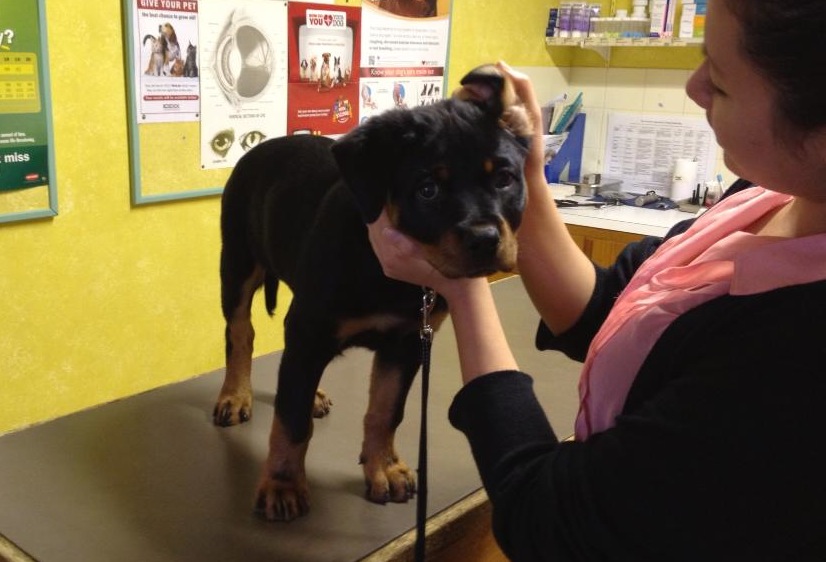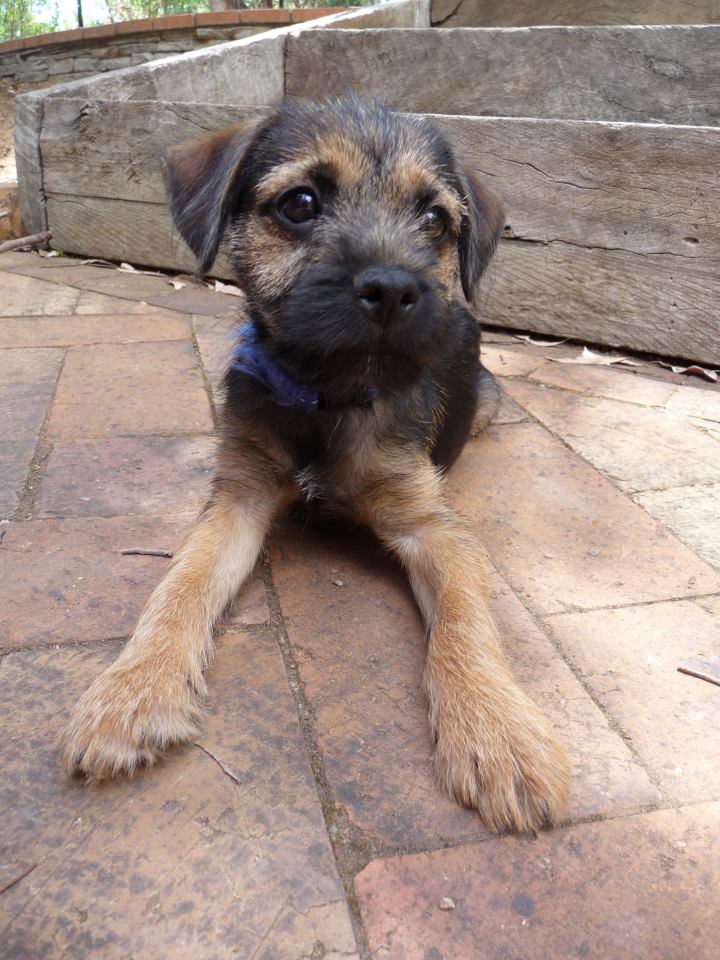Predicting Adults from Puppies – in 15 Minutes!
A typical vet consult is just 15 minutes. Is this long enough for a vet to diagnose future behavioural problems in puppies? Vaccination consults seem to be an ideal time for vets to assess puppies and make recommendations for the future, but is it really enough time for a vet to reach adequate conclusions? Pageat set out to find out.
Listen to audio:
Or read on…

256 puppies were observed during a vaccination appointment at the vet. The puppy was first allowed to ‘free range’ around the room, and then the puppy was examined. The behaviour of puppies during this consult was noted. The owner was also asked to answer 8 questions (on fear, sleep, and self control).
Pageat wondered if the behaviours shown by the puppies and the answers given by their owner might have a correlation between the behaviour (including problem behaviour) the puppy may have as an adult.
Telephone consults occurred 1 month after the vaccination consult, then 6 months after, and then another evaluation was done when the dog came in for its vaccination 1 year afterwards.
Pageat found that there was a correlation, and referred to 6 classifications for adult dogs: ‘normal’, deprivation syndrome, hypersensitivity-hyperactivity, disorder of sensory homeostasis, phobia, and separation anxiety.
This preliminary study showed that there was some merit to Pageat’s ideas. Below are the behaviour classifications that Pageat created and how they correlate to the behaviours and questionnaire responses seen in puppyhood.
Normal Dogs
Pups that were likely to have a ‘normal development’, unsurprisingly, displayed normal behaviours in the vet clinic, like:
- sought comfort from their owner,
- checked out the room while ocassionally checking in with the owner or vet,
- sought vet’s contact,
- had submissive posture when vet reached over the puppy, and
- sometimes cried when restrained, but soon settled.
- On the questionnaire, owners said there were no fears, no sleep problems, and no excessive biting.
So: Puppies that act normally in the vet seem to act normally as adults.
Deprivation Syndrome
‘Deprivation syndrome’ is the term that Pageat used, which means dogs that are under socialised and so fearful of most things, which in turn leads to fear aggression. (source)
In the vet consult, pups were more likely to grow up with deprivation syndrome if they:
- were stationary (didn’t move around the exam room),
- reacted fearfully when touched by the vet,
- remained fearful even when the owner interacted with them,
- persistantly tried to escape and bite from restraint, and.
- if they appeared to calm when restrained, they started fighting again when the restraint was lessened.
- The owner’s responses to the questionnaire described the puppy as ‘fearful’ towards loud noises, moving objects, and people.
That is: puppies that acted fearful during the 15 minute vet consult will probably stay fearful. They should immediately start an intensive socialisation program to try to reduce their fearful reactions.
Hypersensitivity-Hyperactivity Syndrome
‘Hypersensitivity-hyperactivity syndrome’ is basically a dog with lack of control, especially bite inhibition. They are often not-aggressive but nonetheless hurt their owners and others because of their lack of bite inhibition in ‘over the top’ play.
In the vet consult, pups were more likely to grow up with this syndrome if they:
- were active, ran everywhere,
- repeatedly interacted with ‘every thing’ they could in the exam room,
- if this interaction included chewing and often destroying items,
- immediately started to play during the physical exam,
- growled and bit,
- tried to escape restraint by biting, urinating, or defecating, and if this fighting may continue for 30 seconds or more,
- had an owner who’s presence didn’t influence the puppy’s behaviour, and
- had an owner who was covered in bites themselves.
- Owners on the questionnaire indicated the puppy didn’t sleep solidly (i.e. made noise at night) and described the puppy as rough or bitey when playing.
That is: Puppies who seemed hyperactive and orally fixated would stay that way into adulthood. Puppies in this category should be put in puppy playgroups and otherwise taught to inhibit their bite.
Disorder of Sensory Homeostasis
This was the most confusing classification that Pageat used. Here are a couple of definitions I was able to come up with in regard to ‘sensory homeostasis’:
- “the ability to react in a suitable manner to sensory stimulations coming from the external environment” (source)
- “The normal state can be regarded as the normosensoperceptive [normal sensory perceptive] condition to be maintained in the physiological range by means of various cooperative and coordinated mechanisms” (source)
That is, ‘dealing with’ (behaviourally, psychologically, and physically) the environment in a normal way. So, a dog who has ‘sensory homeostasis’ could be described as ‘a dog that reacts suitably to sensory input from its environment’.
The behaviours of puppies in this group were diverse:
- Puppies were active, running everywhere and chewing everything – or they did the opposite, staying in one place resting and not moving much.
- Puppies either began to play when you interacted with them, or just stayed still.
- These puppies bit when they were restrained – sometimes with urinating and defecating as well, but always did not submit.
- The owners reported these puppies were fearful, that they didn’t sleep well or were active, and they were rough biting and playful.
As you can see, there is a lot of variety in this category, and I’m not sure what conclusions can actually be reached. This is especially true when you compare with the rather logical and conclusive results made under different headings.
Phobic Adult Dogs
Dogs were more likely to be fearful adults if they were puppies that:
- sought comfort from owners in new environments,
- if the explored, they checked in with the owner or vet as exploring,
- adopted a submissive posture during handling,
- cried softly during restraint, or
- moved legs when restrained, but soon calms down and is submissive.
That is, the pups that overall seemed quite soft and ‘submissive’ and sought reassurance from people were likely to be fearful dogs in adulthood. These puppies could also have their behaviour remedied by socialisation where they could learn to be more outgoing (as they realise the world is a not-so-scary place).
Separation Anxiety
Separation anxiety is basically a fear of being alone. Pups that exhibited the following behaviours were more likely to have separation anxiety as an adult:
- rests as close as possible to the place it was left,
- vet has to initate contact, and
- pup exhibits fearful behaviours like escaping, biting, urinating, defecating or anal sac excretion, but when the owner approaches, these behaviours stops.
- The owner answered ‘yes’ to fearful behaivours on the questionnaire.
A vet could recommend that puppies displaying these behaviours begin to engage in a separation anxiety program before issues become apparent. Undertaking anti-separation anxiety procedures are good practice, anyway, but could be applied with more emphasis in puppies like this.
Implications
Unfortunately, this research is almost 10 years old and hasn’t been as revolutionary as first hoped. However, it shows there is still promise in the original suggestion: Vets could have a role in preventing problem behaviours from developing or becoming more pronounced by making recommendations based on behaviours seen in a 15 minute consult. Vets are a major source of information for dog owners, including new puppy owners, and almost all puppies will visit a vet for at least their first vaccination. Because of this, it’s vital that we make the most of these consults and direct puppy buyers to appropriate resources.
Links of Interest
Resources for New Puppy Owners
Reference
Pageat, P 2004, ‘Evaluating the quality of behavor development in puppies: preliminary results of a new scale’, Proceedings of the 10th European Congress on Companion Animal Behavioural Medicine.







